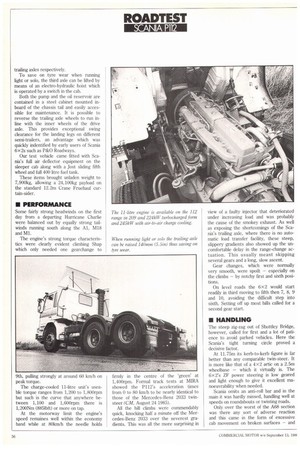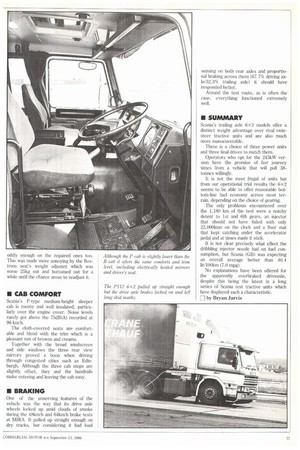BAGS OF
Page 56

Page 57

Page 58

Page 59

If you've noticed an error in this article please click here to report it so we can fix it.
POWER Scania's 6x2 P11 2M is now offered with a choice of three power ratings to suit all kinds of terrain; CM tried it with the most powerful option.
• A few years ago, anyone advocating 224kW (300hp) for a maximum weight tractive unit would hardly have been taken seriously.
Now it is fairly commonplace for manufacturers to offer trucks with that output and more — they are more productive and acceptably fuel efficient.
For several years Scania has marketed
is ratin:s not ably the powerful 14-litre DSC14-01 which, with an output of 309kW (414hp), runs so lightly stressed that it can still return figures of 40lit/1001trn (7.0mpg) and better.
Last year Scania fitted the 245kW (330hp) charge-cooled 11-litre engine to the three-axled P112 as a companion to the 4x2 version. The decision to include it in the 112 range must have pleased those preferring the low-line appeal of the P-cab to the higher, more aggressive looking R-version, but whose operational territories called for more power.
The current six-model P112 range now comprises 4x2 and 6x2 versions, each with two choices of power ratings over the standard 224kW (305hp) turbocharged DS11-15.
Hauliers operating across East Anglia or who run part-laden might prefer the lower, 209kW (280hp) output of the DS11-14, while those working across the Pennines or north of the border would probably seek the extra power of the 245kW (330hp) charge-cooled DSC11-01.
Although relatively rare prior to 1983, three-axled units now account for almost half of the 38-tonners currently in use. They form a hotly contested market sector of around 3,000 units per year.
Scania is the current market leader with a 16.9% share to July — 4.3% down on the same period last year but still ahead of Volvo which is down by 6.9% to 14.7%. ERF with 11.5% and Daf with 10.7% both increased their shares to hold third and fourth places. Irrespective of its market position, Scania is well satisfied with the acceptance of the higherpowered 6x 2s. Since January this year nearly half of those sold have featured the 245kW option.
Accommodating the taller radiator and air-to-air charge-cooler heat exchanger beneath the 245mm lower P-cab did not prove too difficult. It only needed a slightly redesigned front end with a new grille and side panels and no major changes to the floor panels,
• DRIVELINE
Our test vehicle, a P112 6x2 with the most powerful 11-litre engine option, had a near-identical driveline to the 4x2 version sampled over three years ago. The only difference was in the tubeless 12R 22.5 radials in place of the 4 x2's non-standard 12.00 R20 tubed tyres.
They are normally fitted when the sturdier nine-leaf rear suspension is specified.
The DSC11-01 produces its 245kW maximum net output at 2,000rpm while it torque peaks at 1,395Nm (1,025 lbft) at 1,250rpm to the EEC standard.
Scania's GR871 ten-speed rangechange gearbox comes as standard with both the 224kW and 245kW engines. It has a deep, 13.5:1 bottom gear ratio and a direct drive 1:1 tup gear.
Fitted with the tallest available 3.50 final drive, the 6X2 produces 56.8Km/h (35.3mph) per 1,000rpm in top gear and a maximum geared speed of 114km/h (70.6mph).
• SUSPENSION
Of the three-axled tractive units currently available, Scania 6x2s with their simple trailing rear axles, are among the lightest. While the front suspension comprises _seven-leaf springs and double-acting dampers, the centre (drive) axle has hefty 10-leaf semi-elliptics linked through balance beams to the trailing axle. Imposed semi-trailer weight is distributed On the basis of 55.6/44.4% to e driving and trailing axles respectively.
To save on tyre wear when running light or solo, the third axle can be lifted by means of an electro-hydraulic hoist which is operated by a switch in the cab.
Both the pump and the oil reservoir are contained in a steel cabinet mounted inboard of the chassis tail and easily accessible for maintenance. It is possible to reverse the trailing axle wheels to run inline with the inner wheels of the drive axle. This provides exceptional swing clearance for the landing legs on different semi-trailers, an advantage which was quickly indentified by early users of Scania 6x 2s such as P&O Roadways.
Our test vehicle came fitted with Scania's full air deflector equipment on the sleeper cab along with a Jost sliding fifth wheel and full 400 litre fuel tank.
These items brought unladen weight to 7,900kg, allowing a 24,100kg payload on the standard 12.2m Crane Fruehauf curtain-sider.
• PERFORMANCE
Some fairly strong headwinds on the first day from a departing Hurricane Charlie were balanced out by equally strong tailwinds running south along the Al, M18 and Ml.
The engine's strong torque characteristics were clearly evident climbing Shap which only needed one gearchange to 9th, pulling strongly at around 60 km/h on peak torque.
The charge-cooled 11-litre unit's useable torque ranges from 1,200 to 1,800rpm but such is the curve that anywhere between 1,100 and 1,600rpm there is 1,200Nm (885Ibft) or more on tap.
At the motorway limit the engine's speed remaines well within the economy band while at 80km/h the needle holds The 11-litre engine is available on the 112 range in 209 and 224kW turbocharged form and 245kW with air-to-air charge cooling.
When running light or solo the trailing axle can be raised 140mm (5.5in) thus saving on tyre wear.
firmly in the centre of the 'green' at 1,400rpm. Formal track tests at MIRA showed the P112's acceleration times from 0 to 80 km/h to be nearly identical to those of the Mercedes-Benz 2033 twinsteer (CM, August 24 1985).
All the hill climbs were commendably quick, knocking half a minute off the Mercedes-Benz 2033 over the severest gradients. This was all the more surprising in
view of a faulty injector that deteriorated under increasing load and was probably the cause of the smokey exhaust. As well as exposing the shortcomings of the Scania's trailing axle, where there is no automatic load transfer facility, these steep, slippery gradients also showed up the uncomfortable delay in the range-change actuation. This usually meant skipping several gears and a long, slow ascent.
Gear changes, which were normally very smooth, were spoilt — especially on the climbs — by notchy first and sixth positions.
On level roads the 6x2 would start readily in third moving to fifth then 7, 8, 9 and 10, avoiding the difficult step into sixth. Setting off up most hills called for a second gear start.
• HANDLING
The steep zig-zag out of Shottley Bridge, however, called for first and a lot of patience to avoid parked vehicles. Here the Scania's tight turning circle proved a decisive factor.
At 11.75m its kerb-to-kerb figure is far better than any comparable twin-steer. It is more like that of a 4x2 artic on a 2.5m wheelbase — which it virtually is. The 6x 2's ZF power steering is low geared and light enough to give it excellent manoeuvrability when needed.
Scania omits an anti-roll bar and in the main it was hardly missed, handling well at speeds on roundabouts or twisting roads.
Only over the worst of the A68 section was there any sort of adverse reaction and this came in the form of excessive cab movement on broken surfaces — and oddly enough on the repaired ones too. This was made more annoying by the Bostrom seat's weight adjuster which was some 25kg out and bottomed out for a while until the chance arose to readjust it.
• CAB COMFORT
Scania's P-type medium-height sleeper cab is roomy and well insulated, particularly over the engine cover. Noise levels rarely got above the 75dB(A) recorded at 96 km/h.
The cloth-covered seats are comfortable and blend with the trim which is a pleasant mix of browns and creams.
Together with the broad windscreen and side windows the three rear view mirrors proved a boon when driving through congested cities such as Edinburgh. Although the three cab steps are slightly offset, they and the handrails make entering and leaving the cab easy.
• BRAKING
One of the unnerving features of the vehicle was the way that its drive axle wheels locked up amid clouds of smoke during the 48km/h and 641(m/h brake tests at MIRA. It pulled up straight enough on dry tracks, but considering it had load sensing on both rear axles and proportional braking across them (67.7% driving axle/32.3% trailing axle) it should have responded better.
Around the test route, as is often the case, everything functioned extremely well.
• SUMMARY
Scania's trailing axle 6><2 models offer a distinct weight advantage over rival twinsteer tractive units and are also much more manoeuverable.
There is a choice of three power units and three final drives to match them.
Operators who opt for the 245kW version have the promise of fast journey times from a vehicle that will pull 38tonnes willingly.
It is not the most frugal of units but from our operational trial results the 6X2 seems to be able to offer reasonable bottom-line fuel economy across most terrain, depending on the choice of gearing.
The only problems encountered over the 1,180 km of the test were a notchy detent to 1st and 6th gears, an injector that should not have failed with only 22, 000Iuns on the clock and a floor mat that kept catching under the accelerator pedal and at times made it stick.
It is not clear precisely what effect the dribbling injector nozzle had on fuel consumption, but &aria (GB) was expecting an overall average better than 40.4 lit/100km (7.0 mpg).
No explanations have been offered for the apparently overbraked driveaxle, despite this being the latest in a long series of Scania test tractive units which have displayed such a characteristic.
ID by Bryan Jarvis




























































































